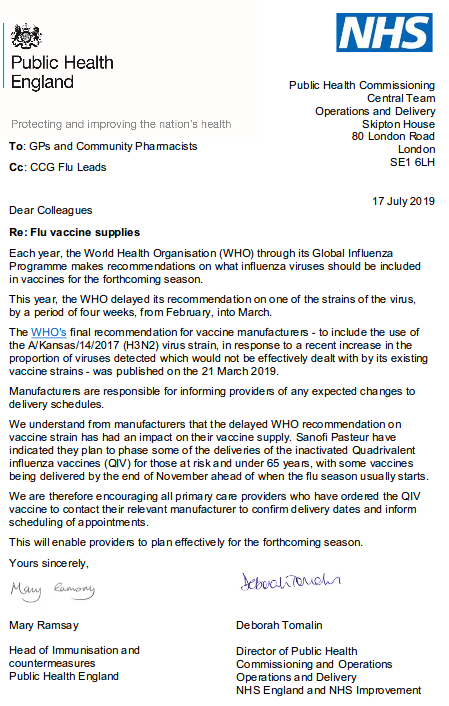
#14,197
Last February the World Health Organization delayed their decision on which H3N2 vaccine component to add to this fall's seasonal flu shot by 30 days due to late season reports of the rapid rise and spread of an H3N2 clade 3C.3a virus in the United States and other parts of the globe.
When they made their selection in late March, the WHO warned that the delay could cause a delay in shipping vaccines in the fall.In early June Taiwan announced that their fall flu vaccine campaign - which normally begins on October 1st - would be delayed until mid-to-late November, and that initial supplies would be limited (see Taiwan Warns Of Delays In This Fall's Flu Vaccine).
In early July Sanofi Pasteur announced (see AAP news report) that deliveries of this fall's vaccine would likely be delayed in the U.S. as well, stating:
“Sanofi Pasteur fully expects to manufacture and deliver every dose reserved by our customers, beginning with partial shipments to all customers in late-August or September, with all shipments completed by the end of November."This week the UK's Public Health England and NHS England have issued a letter to GPs and Community Pharmacists regarding the delayed arrival of the quadrivalent vaccine this fall.
All of this comes on the heels of an announcement last May by AstraZeneca that the supply of FluMist Quadrivalent - a live attenuated influenza vaccine (LAIV) - would be limited this fall (see AAP News report Nasal spray flu vaccine supply will be limited next season).
As we discussed less than a week ago (see ECDC: Influenza Virus Characterisation, June 2019), the number of antigenically distinct flu strains co-circulating around the globe increases every year, and with that diversity comes great challenges in picking the `right' strains to include in the flu shot.Whether the delayed decision on this year's H3N2 vaccine strain will prove to be the `right one' remains to be seen. Complicating matters, the strain that circulates in Europe, or Asia, can differ antigenically from what we see in North America.
Meaning that this fall's vaccine strain could be well matched for some regions of the globe, but something less-than-optimal for others.Even with the expected delays, adequate supplies of the flu vaccine should be widely available by late November. Despite some shortcomings, the flu jab remains the best way to protect yourself against influenza in the year ahead.
Some recent studies on health risks you might not associate with influenza infection include:
AHA: Flu, Flu-like Illnesses Linked to Increased Risk of Stroke, Neck Artery Tears
Chest: Flu Vaccine Reduces Severe Outcomes Among Hospitalized Patients With COPD
Eur. Resp.J.: Influenza & Pneumonia Infections Increase Risk Of Heart Attack and Stroke
NEJM: Acute Myocardial Infarction After Laboratory-Confirmed Influenza InfectionAll reasons why I'll be rolling up my sleeve again this fall to get the vaccine.
